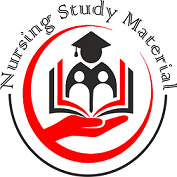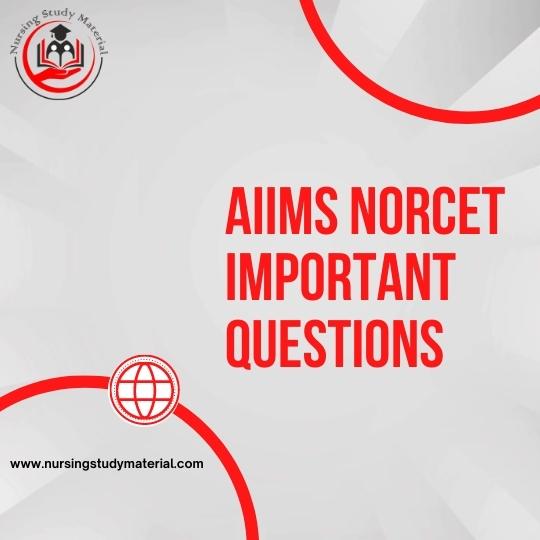How one should prepare for AIIMS Norcet Examination, is to do the AIIMS Norcet Important and Previous Year Questions asked in the examinations. However, the confusion in the mind of the aspirant doesn’t end here. There are multiple queries that arise during the preparation. Making an effort through this website to clear every doubt that an aspiring candidate has while preparing for this coveted examination, Nursing Study Material has brought to you some AIIMS Norcet Important Questions to help you in your preparation.
AIIMS Norcet Important Questions
1. Duodenal ulcer — may indicate high gastric acid levels.
2. Potassium — is the major intracellular cation.
3. Tetany — with muscle spasm would indicate hypocalcemia.
4. The pH of blood is maintained with in the normal range — 7.35 to 7.45.
5. The normal range of urine specific gravity — 1.010 to 1.025.
6. Excess CO2 in the blood combines with water to from — H2CO3 (carbonic acid).
7. Heparin & Coumadin — (the oral form of warfarin) and anti-co-agulants will prevent further clots forming.
8. Sodium bicarbonate — is the base and one the major buffers in the body.
9. Kayexalate — should bring the potassium level down.
10. Kidney — regulate fluid balance by adjusting the amount of fluid reabsorbed from the glomerular filtrate.
11. Renal System — controls the excretion of sodium and potassium through countercurrent mechanism.
12. Calcium — is most abundant electrolyte in the body (99% is concentrated in the teeth and bones).
13. Systemic Alkalosis — may cause prolonged use of sodium bicarbonate.
14. Hyperventilation — will cause respiratory alkalosis.
15. Long-term steroid — use depress the immune system making the client susceptible to infection.
16. The average adult human body is about — 60% of water.
17. The normal Hgb for a female is above — 12-16 g/L.
18. Apical heart rate — is best counted at the point of maximum impulse.
19. Neutrophils — are the first line defence against infection.
20. Pneumonia — is a major complication of unresolved atelectasis.
21. Tachycardia — is the term used for rapid heart rate.
22. Polycythemia — is reflected in an elevated hematocrit level.
23. Brudzinski’s sign — in with flexion of the head cause flexion of the knees and thigh is sign of meningeal irritation.
24. Normal CVP reading is between — 5-10 cm H2O.
25. Cardiac compression rate in adult — 4-5 cm (1 ½ - 2 inches).
26. Oxygen — is necessary for growth of cells.
27. Congestive heart failure — is the failure of the heart to pump adequately to meet the need of the body.
28. Normal prothrombin time — 12–14 sec.
29. Tetralogy of Fallot — include right ventricular hypertrophy, ventricular septal defect, stenosis of pulmonary artery and overriding aorta.
30. SA — node is the natural pacemaker of heart.
31. Antihypertensive — agents lower peripheral vascular resistance and may cause orthostatic hypotension.
32. Epinephrine — would increase BP by stimulating cardiac contractility.
33. Asystole — refers to the absence of atrial and ventricular contractions, which can cause death with in minutes.
34. Buerger’s disease — is characterized by vascular inflammation, usually in the lower extremities, leading to thrombus formation.
35. Mitral stenosis — impairs blood flow from left atrium to left ventricle.
36. Intermittent claudication — is a condition that indicates vascular deficiencies in the peripheral vascular system.
37. Myocardial infarction (MI) — may caused increased irritability of tissue or interruption of normal transimmission of impulses.
38. Dysrhythmias — occur in about 90% of clients after MI.
39. Congestive heart failure — accumulation of fluid in the interstitial space and aveloi of lungs cause dyspnea.
40. Angina pectoris — is a pain in the chest that is caused by hypoxia of the cardiac muscle.
41. Irreversible brain damage — will occur of a client is anoxic for more than 4 minutes.
42. Ischemia — causes tissue injury and release the bradykinin chemicals that stimulate sensory, nerve and produce pains.
43. Xylocaine — decreases the irritability of the ventricles in the treatment of ectopic beats.
44. Digoxin — slows and strengths the ventricular contractions.
45. Thrombophebitis — is the inflammation of a vein that occur with the formation of a clot.
46. Thallium scan — detects myocardial damage and perfusion.
47. Dopamine — will cause vasoconstriction peripherally, result peripheral pressure rises.
48. Cardioversion — is a procedure used to convert certain dysrhythmias to normal rhythm.
49. Subtotal gastrectomy — includes small frequent diet.
50. Hydrochloric acid — is essential for absorption of fat soluble vitamins in the intestine.
51. Sengstaken Blakemore Tube — is used to stop bleeding (stomach and esophagus).
52. Vincent’s agina — is a acute gingivial infection.
53. Vitamin B12 — is absorbed in the ileum.
54. Vitamin K — is required for the synthesis of pro-thrombin.
55. Flapping hand tremors — accumulation of nitrogenous waste in hepatic coma affects the nervous system.
56. Saturated fats — found in animal tissue.
57. Unsaturated fats — that are found in vegetable oils.
58. Chadwick’s sign — is the purplish decoloration of vaginal mucus.
59. Hegar’s sign — is softening of the lower uterine segment.
60. Goodell’s sign — is softening of the cervix.
61. The respiratory center is stimulated by CO2.
62. Hypoxia — may indicate high risk for airway obstruction, restlessness and dyspnea.
63. Cheyne-stokes respiration — periods of hyperpnea alternating with periods of apnea.
64. Atelectasis — is a complete or partial collapse of entire lung.
65. Decreased O2 — in the vital centres in the brain results in restlessness and mental confusion.
66. Laryngeal spasms — can occur abruptly patency of airway, is determined by constant assessment for symptoms of respiratory distress.
67. Hemoptysis — is described as expectoration of blood.
68. Hematoma — refers to a local accumulation of blood in the tissue.
69. Hematuria — refers to blood in the urine.
70. Build-up of CO2 cause cardiac arrhythmias.
71. Acute respiratory failure — is marked by hyper capnia, hypoventilation and hypoxemia.
72. Beta-adrenergic agonists — cause bronchodilation which is the opening up of narrowed airway.
73. Classic sign of tuberculosis — increased cough, hemoptysis and night sweats.
74. Tidal volume — is the amount of air inhaled and exhaled while breathing normally.
75. Vital capacity — is air that can be forcibly expired after deep inspiration.
76. Expiratory reserve — is the maximum amount of air that can be expired after expiration of the tidal volume.
77. Inspiratory reserve — is the maximum amounts of air that can be inspired following the inspiration of the tidal volume.
78. Respiratory acidosis — represents an increase in the acid component CO2.
79. Mycobacterium tuberculosis — is the causative organism of TB.
80. Choanal atresia — is lack of opening between one or both of the nasal passages and the nasopharynx.
81. PEEP — Positive End Expiratory Pressure.
82. Chest physiotherapy — is given to a patient to mobilize the secreations.
83. Emphysema — is a common complicatin of chronic asthma.
84. Pneumothorax — results in decreased surface area for gaseous exchange.
85. Respiratory tract — obstructions usually occur in the larynx, trachea or major bronchi.
86. Chronic hypoxia — associated with COPD may stimulate excessive RBC production (polycythemia).
87. Furosemide — is a rapidly acting diuretic that acts on the loop of heule by increasing the excretion of chloride and sodium.
88. Cystic fibrosis — is characterized by an overproduction of viscid mucus by exocrine gland in the lungs.
89. Orthopenic position — refers to sitting up and leaning slightly forward which allowing the lungs for expansion.
90. Vitamin A — is used for the formation of retinal, a component of the light-senstive rhodopsin molecules.
91. Tracheostomy tubes — carry several potential complications including laryngeal nerve damage, bleeding and infection.
92. Cisplatin — may depress the bone marrow, thereby interfering with the production of WBC.
93. Cataract — is the clouding of crystalline lens or its capsule.
94. The middle ear contains 3 ossicles — Malleus, Incus & Stapes.
95. Meniere’s disease — is a build-up of lymph fluid in the ear.
96. Cataract — patient’s usually complains of dimness, blurring or hazy visions.
97. Florence Nightingale — is the founder of modern nursing.
98. Nitroglycerine — is administered by sublingual route.
99. Lund-Browder — chart used for BURNS.
100. Mutism — is term as absent of speech and activities.

